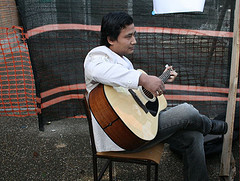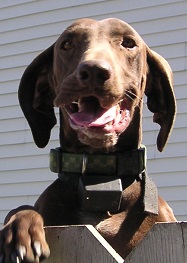Now is a good time to look at the amount of tax that you have withheld from your pay, pension or Social Security, as well as any estimated payments that you make throughout the year. The amount of any payment that you had to make on April 15 should be fresh in your mind. If it was a sizable amount you should review the situation and quite possibly adjust your withholding or estimated payments.
It’s also possible that you’ve been having more tax withheld than necessary. If you received a rather large refund, you’re essentially giving the government a tax-free loan of your money for a good part of a year. Many folks like to receive a big refund, it’s sort of a “bonus” each year, but you could help yourself out paycheck-by-paycheck if you adjusted withholding. If you still want the “bonus” effect, set up an automatic deposit into a savings account and make it “hands off”. Then in April you can withdraw the money and do whatever you would have done with the refund.
 |
| Image by GStevens via Flickr |
For example, if you commonly receive a $2,500 refund, you could adjust your withholding so that you get an extra $100 per month in your take-home pay, and still have a $1,300 refund after filing your taxes. Better yet, adjust your withholding to have an extra $200 in take-home pay and then you’ll still get a $100 refund.
So How Do You Do It?
First of all, you need to estimate how much your total pay is going to be for the year. You can start with your pay stub for the current month – then project out for the remainder of the year how much your total pay will be at the end of the year. The same would be true for pensions and Social Security payments. Be sure to use the “taxable gross” or perhaps “gross pay” figures for your calculations, not the take-home amount. If you only have a “gross pay” figure, understand that some deductions will come out of your check pre-tax, like a 401(k) contribution, so you’ll want to reduce the “gross pay” figure by those deductions to come up with your taxable income.
Having calculated the total taxable income you’ll receive for the year, make the same sort of calculation to project the amount of income tax you’ll have withheld for the year. Do the same thing for your state income tax withholding (if you’re lucky enough to live in one of the states that imposes an income tax).
Don’t forget to include any planned IRA distributions (including Roth Conversions) as income, along with any tax you plan to withhold from these distributions. Also calculate any capital gains or losses you may be planning during the year, as well as your dividends you’ll receive.
If you have self-employment income, the calculation becomes a bit more difficult. To be conservative, just subtract your expected expenses from your expected income to produce a net income figure to work with.
Next, go to the IRS website and locate Form 1040-ES for the current year. This form will help you to complete the calculations. Follow the instructions on the form, using your prior year’s tax return to help you with things like any credits you will receive. In the instructions for form 1040-ES, you’ll also find the tax rates to apply to your projected taxable income for the year.
You’ll need to make sure that your total withholding and estimated payments tally up to at least 90% of the projected tax you’ll owe, or 100% (110% if your AGI is $150,000 or more) of your prior year’s tax amount (whichever is less). If your withholding is less than the prior year’s tax and more than $1,000 less than the 90% figure for this year’s tax, you could be subject to a penalty for underpayment. Generally this is only applied if you have had a significant underpayment in the previous year (the first year is a “gimme”).
You’ll also want to locate the estimated tax payment calculations for your state tax withholding and run through the numbers there as well.
Okay, I did that. Now what?
If you’re underpaying your tax significantly, now it’s time to figure out how to reconcile the situation. (If you’re overpaying tax and you want to increase your take-home pay or net payments from pensions or Social Security, you can use similar measures.) The tactics you use depend upon the type of pay that you receive:
W2 Pay (regular employee pay): If you are receiving a paycheck from an employer, you can make adjustments to the amount of pay that is being withheld by using Form W4 – available from your Human Resources department. Follow the instructions for the form, making adjustments for your pay as it continues through the remainder of the year so that you have a total withholding that is appropriate for your projected taxable income. A simple way to do this is to request a specific amount to be withheld in addition to your regular withholding. Many employers provide access to a substitute Form W4 online.
Pensions: Much the same as with W2 pay, you make adjustments to your withholding for pension payments using Form W4P, which will be available from your pension administrator. Use the same methods of calculation mentioned above with W2 pay. Many pension providers have an online facility to allow changes to Form W4P withholding.
Social Security: Same as pensions and W2 pay. You will be using Form W4V, available from the Social Security Administration. This is also available online at SocialSecurity.gov.
IRA or 401(k) Distributions: When you take a distribution from an IRA or 401(k) account, one part of your distribution includes the ability to withhold taxes from the distribution. You can increase the total tax you’ve had withheld for the year by having some of your distribution withheld in taxes. Distributions from 401(k) plans automatically have 20% withheld, although you can increase that amount. You may not decrease it, however. IRAs do not have this mandatory withholding.
When doing a Roth Conversion, you need to keep in mind that any amount that you don’t convert by either having it withheld for taxes or just taking as a regular distribution will not only be taxed but also can be subjected to the early withdrawal 10% penalty if you’re under age 59½.
1099 Pay (such as an independent contractor) or self employment income: In this case you can make estimated payments using the vouchers included with Form 1040-ES. You’ll want to make these payments in a timely fashion – April 15, June 15, September 15 and January 15 – for the amount of net income you’ve received up to the end of the prior month. Don’t forget to run the calculations for your self-employment income and include that in your estimated payments.
You can make estimated payments no matter what sort of income you receive throughout the year, in addition to the Form W4 adjustments mentioned above. Failure to make these payments in a timely manner can also result in interest and penalties for underpayment.
Timeliness
Bear in mind, the quarterly estimated payments are necessary to be made within specific timeframes. Form W4 withholding is also sent to the IRS (by your employer) regularly, in a timely fashion. Withholding from an IRA or 401(k) distribution is the only one that doesn’t have to be spread out over the year. For example, if you found that your tax withholding was going to be too little for the year, you could wait until December and make up the difference using an IRA distribution withholding mentioned above (this is not recommended). See the article IRA Trick – Eliminate Estimated Tax Payments for more details.

















 With apologies to the writer and performers of the original “Sam, You Made The Pants Too Long!”… This article is about what happens when your IRA declines substantially in value and you’ve put a 72t Series Of Substantially Equal Periodic Payments plan (SOSEPP) into play – and the decline in value has brought your IRA to a point where the balance will no longer support your Equal Payments.
With apologies to the writer and performers of the original “Sam, You Made The Pants Too Long!”… This article is about what happens when your IRA declines substantially in value and you’ve put a 72t Series Of Substantially Equal Periodic Payments plan (SOSEPP) into play – and the decline in value has brought your IRA to a point where the balance will no longer support your Equal Payments.
 One of the biggest misconceptions about Social Security is that each individual has a specific “account” which holds all the money you’ve had withheld from your paycheck over the years. Nothing could be further from the truth… as we’ve mentioned before on this blog, the Social Security system is a pay-as-you-go system (largely) where withholding today is used to pay benefits for current recipients.
One of the biggest misconceptions about Social Security is that each individual has a specific “account” which holds all the money you’ve had withheld from your paycheck over the years. Nothing could be further from the truth… as we’ve mentioned before on this blog, the Social Security system is a pay-as-you-go system (largely) where withholding today is used to pay benefits for current recipients.





 Sterling Raskie, MSFS, CFP®, ChFC®
Sterling Raskie, MSFS, CFP®, ChFC® The latest in our Owner’s Manual series, A 401(k) Owner’s Manual, was published in January 2020 and is available on
The latest in our Owner’s Manual series, A 401(k) Owner’s Manual, was published in January 2020 and is available on  A Medicare Owner’s Manual, is updated with 2020 facts and figures. This manual is available on
A Medicare Owner’s Manual, is updated with 2020 facts and figures. This manual is available on  Social Security for the Suddenly Single can be found on Amazon at
Social Security for the Suddenly Single can be found on Amazon at  Sterling’s first book, Lose Weight Save Money, can be
Sterling’s first book, Lose Weight Save Money, can be  An IRA Owner’s Manual, 2nd Edition is available for purchase on Amazon. Click the link to choose the
An IRA Owner’s Manual, 2nd Edition is available for purchase on Amazon. Click the link to choose the  Jim’s book – A Social Security Owner’s Manual, is now available on Amazon. Click this link for the
Jim’s book – A Social Security Owner’s Manual, is now available on Amazon. Click this link for the  And if you’ve come here to learn about queuing waterfowl, I apologize for the confusion. You may want to discuss your question with Lester, my loyal watchduck and self-proclaimed “advisor’s advisor”.
And if you’ve come here to learn about queuing waterfowl, I apologize for the confusion. You may want to discuss your question with Lester, my loyal watchduck and self-proclaimed “advisor’s advisor”.